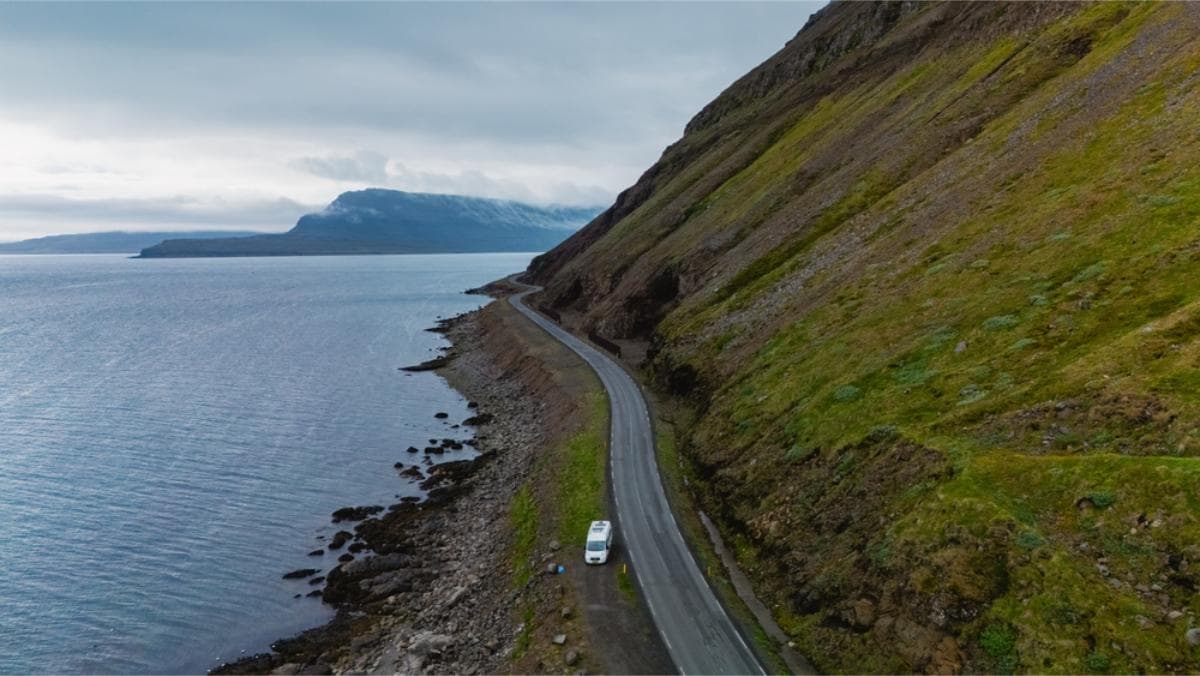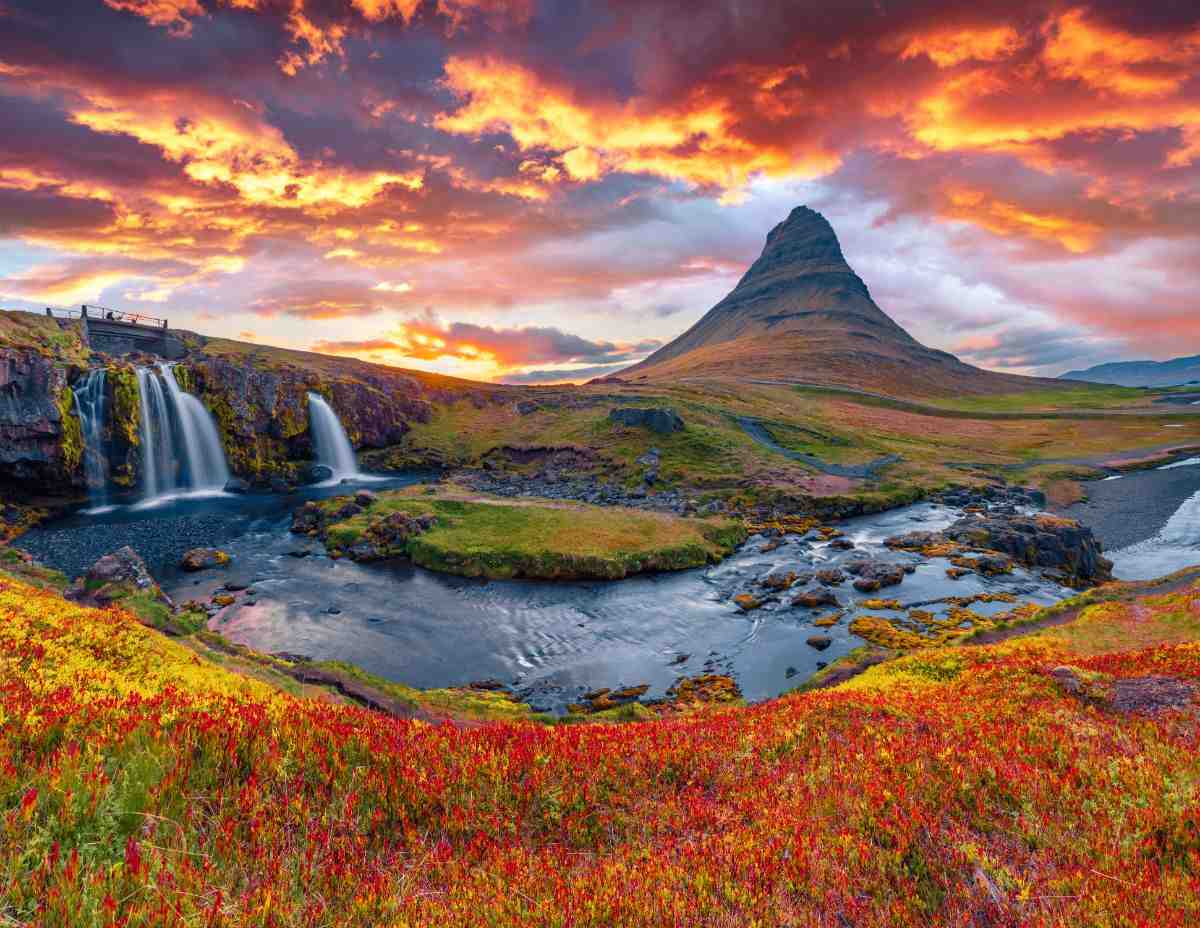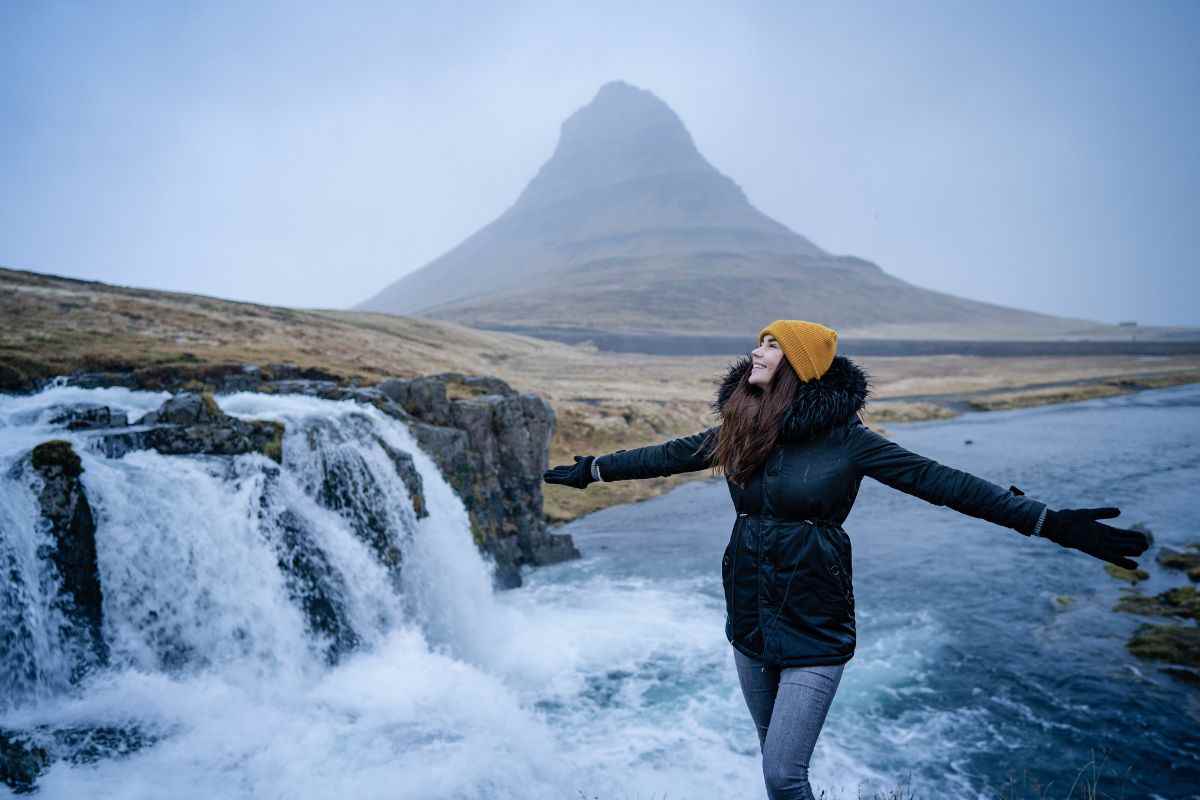
22 December
8 min read
Iceland Roads: What Google Maps Won’t Warn You About

13 June 2022
13 min read
Iceland is situated high up in the North Atlantic Ocean not that far from the Arctic Circle. Along with its name, this might lead you to assume that it is always freezing, but that is far from the truth. Iceland has a weather pattern and climate that shifts greatly, and you can actually enjoy a relatively warm summer as well as a snow-covered winter throughout the year.
This guide will give you the information you need to plan the vacation you want according to the Iceland weather you like.
Ready to get the lowdown on the local weather so you can start planning your trip? Well, let’s dive in!

There is an old saying in Iceland: ‘You could experience all four seasons in a day if you’re lucky’. It’s a phrase often used by Icelanders to describe how volatile the weather can be during some periods of the year, and it is actually true! You can experience warm sunshine, heavy rain, peaceful snow, and hard wind, all in the same spot and in a single day!
One of the best things about Iceland's weather is the fact that the temperature never gets too warm or too cold. Iceland's average temperature in the winter months usually ranges from around -10 °C to 0 °C, while Iceland's average temperature in the summer can vary between 2°C and 20°C.
If you’re equipped with clothing that can withstand wind and rain, you won’t have any major issues dealing with these temperatures. If you don't know what clothes to wear in Iceland, make sure you check our guide out!
The Icelandic climate in general is, in fact, far milder than most people believe. This relatively temperate climate is all down to the warm ocean currents of the Gulf Stream a the volcanic activity under the island.
Just like most other countries, the weather in Iceland changes by the season, but it might look different to what you are used to. Due to where Iceland is located on the map, they have different characteristics of their seasonal weather. The Iceland weather by month won’t correspond to what most people in the Northern Hemisphere are used to and is determined by the harsh Iceland climate.

There's something you need to know before traveling to Iceland in Spring: officially speaking, Iceland doesn’t have a spring season. Instead, its climate is often talked about in terms of just winter and summer. During what most of the Northern Hemisphere would consider springtime, the Iceland spring weather still feels very wintery in Iceland.
Relatively speaking, however, the spring in Iceland is nothing short of magical, as it is the time when nature goes from dormant to awake. With the roaring waterfalls, it is as if the mountains themselves are coming alive.
From June to August Iceland experiences its summertime. This is also the tourist high season and the best time of year for hiring a campervan in Iceland. Even though this is summer, Iceland’s notoriously changeable Iceland summer weather can still throw many a curveball. Days can feel cold if the wind blows from the north and there may well be plenty of rainy days.
Again, this is a crossover season and doesn’t really exist in Iceland. Summer-like weather conditions can continue well into September. At the same time, Autumnal conditions can start to show from as early as late August.
The Iceland fall weather is like spring in reverse. Rain and wind are starting to build up during this season, but don’t bother with an umbrella unless you want to re-enact that famous Mary Poppins scene.
Iceland's winter weather stays for a long time, with real winter wonderland magic. The lowest ever temperature recorded was in the winter of 2018 when the mercury dropped to minus 38°C! But this was an extreme occurrence. The temperatures can go down to -20°C regularly in the northern part of Iceland but stay close to 0°C in the south.
The Iceland weather in winter is snowy and cold, with long nights. In the depths of winter in Iceland, the sun never really rises. Instead, there is a beautiful twilight that turns the landscape golden if the skies are clear. This is the time of year when the Northern Lights in Iceland can be most frequently spotted.
Now that we’ve covered what the weather is like in Iceland and explored how the climate changes from one season to another, let’s zoom in on the Icelandic weather even further and take a look at what it’s like month by month!
|
Month |
Avg High temperature |
Avg Low temperature |
Avg Rainfall |
Avg Sunlight |
|
January |
2°C |
-2°C |
100mm |
5 hours |
|
February |
2°C |
-2°C |
107,5mm |
8 hours |
|
March |
3°C |
-1°C |
92,5mm |
12 hours |
|
April |
6°C |
1°C |
92,5mm |
16 hours |
|
May |
9°C |
4°C |
57,5mm |
18 hours |
|
June |
12°C |
8°C |
52,5mm |
21 hours |
|
July |
14°C |
9°C |
67,5mm |
19 hours |
|
August |
13°C |
8°C |
87,5mm |
16 hours |
|
September |
10°C |
6°C |
115mm |
13 hours |
|
October |
7°C |
2°C |
112,5mm |
9 hours |
|
November |
4°C |
-1°C |
105mm |
6 hours |
|
December |
2°C |
-2°C |
102,5mm |
4 hours |
Source: Tripsavvy
When we get into the Iceland weather of January, it is known as the dry winter month. Rain and snowfall are declining, and the air literally glimmers with ice crystals. If you want to experience absolute calm and quiet, January is a great month to visit Iceland. When it comes to the Iceland temperature by month, January in Iceland takes the place as the coldest of the cold as it is in the heart of winter.
The last stretch of the really cold and dark winter begins when we enter the Iceland weather of February. Temperatures will still be very low, but the days are slowly starting to become longer, and life on the island is waking up. At the end of February, the rain will start to pick up again.

As said, spring is a relative term, and the weather starts to shift in the different parts of Iceland in March. While it can still be considered winter in the north, the temperatures are starting to creep up towards classic Icelandic spring weather. You will also start to notice the days getting longer and you can enjoy the sun a little bit more every day when the Iceland weather in March is in full swing.
Iceland's April weather can be quite chilly, and snow can keep falling well into this month. There are plenty of activities in Iceland in April, as we move into the last stretch of winter options like ice cave diving and skiing. At the end of April, though, the temperature in Iceland is stabilizing over the 0°C mark, and spring, as most of us know it, will start to make its appearance.
The Iceland weather in May can start to feel summery. This is one of the driest months of the year, so it is a good month for hiking and sightseeing. By mid-May, there are about 18 hours of daylight in Southern Iceland. This time of year, most of the snow in Iceland is thawing out and the runoff from the winter’s snow deposits fills up the rivers and waterfalls.

Iceland's weather in June is characterized by warm sun and the longest days of the year. You shouldn’t expect an abundance of rainfall and the temperatures can start to go up to 15°C during the days. Due to the warming summer Iceland climate and long days, you won’t have any luck seeing the northern lights, unfortunately.
When we talk about Iceland's temperature by month, July is the king of warm weather. Iceland weather in July comes right after midsummer. The temperatures will rise for most of the month and often keep a steady 15-20°C during the better parts of the days.
This is late summer when humidity is starting to properly return to the island, and with it comes the wind and rain. The Iceland weather in August represents the country well, as this is one of those months that you could have the chance to experience the entire repertoire of the weather in Iceland in a single day. Temperatures can still be around 15°C, but they also have a fair chance of closing in at 5°C, so pack with that in mind.

Crowned the wettest month, Iceland weather in September makes this a good month to visit this mystic island if you like big waterfalls. The temperature in Iceland might still be comfortable, but be ready for the heavy rains that are likely to come.
This is the month you will notice the days getting shorter and the weather becoming harsher. Iceland weather in October is known as the threshold month that properly depicts the Iceland weather in the fall. More frequent rainfall will build up.
Still, if you have plenty of things to do in Iceland in October, do not worry. This type of rain will be lighter, but go on for longer, and why waterproof clothing is a must.
As the days are getting significantly shorter and the rains lightly continue to hammer the land, temperatures in November in Iceland will creep down to below 0°C at times and keep at around 5°C. Iceland weather in November is known for creating conditions in which you are likely to encounter the first snowfall and slippery roads. The silver lining? The season for Skiing in Iceland is about to get started!
December in Iceland is the official month of the winter wonderland! As the rain shifts to snow and the air becomes drier, you are very likely to start experiencing those perfect -5°C days with classic Christmas weather. When it isn’t too cold to play in the snow and not too warm for the snow to melt.
Iceland's weather in December is known for being cold and dark. You are likely to experience as little as 2 hours of daylight if you’re in the north and 4 hours in the south.

As you can see, Iceland weather by month can differ tremendously as the seasons change. Finding out what is the best month to travel to Iceland solely depends on your preferences. Iceland is a robust country with weather that is as likely to challenge your resilience as well as reward it. Once you're there, don't forget to check the weather forecast page daily to always be on the safe side.
Bear in mind the wind in Iceland can be quite strong, when the wind blows, it really blows! So, sturdy clothing and an open mindset are must-haves to truly enjoy everything the island has to offer.
If you want to have adventures, late spring and summer are the best seasons to visit. For a calm winter getaway with tranquil nature and dazzling light displays in the sky, mid-winter will be your best choice. If you want to see, feel, and listen to the full-force display of the powerful weather, late fall or early spring won’t disappoint.
Whether you’ll be traveling the country during the sunny summer months or cozying up indoors during the winter months, renting the best campervan might just be the thing to make your Icelandic stay a memorable one. Check out your options today!
More Iceland Stories to Explore
Discover more tips and tales to fuel your next saga
Join thousands who have booked with us
Iceland's most booked campervan of 2025 is waiting. Secure yours today!
Your rental comes with:
Handy Extras
Essential Insurance Plan
Unlimited Mileage
Flexible Cancellation